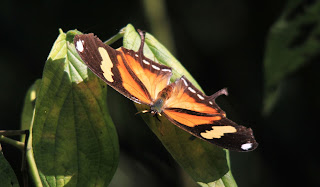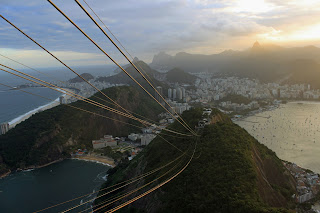During the flooded season it is difficult to see most of the smaller passerines such as antbirds but the larger species are still prominent.
One of our target species was the prehistoric hoatzin, a species with its own family (Opisthocomidae) and sub order. The taxonomy of the species is still a debate but it is thought that it shares most similarities with the cuckoo family. The chicks are particularly interesting because they are born with a thumb and finger on their wings to aid them in the trees during fledging. We found 3 colonies of hoatzins, including one right behind the lodge.
Hoatzin.
Some of the other birds we saw included chestnut-bellied macaw, scarlet macaw, festive parrot, tui parakeet, white-throated toucan, chestnut-eared aracari, black-fronted nunbird, green oropendola, russet-backed oropendola, razor-billed currasow, sungrebe, horned screamer, limpkin, yellow-rumped cacique, bare-necked fruitcrow, yellow-tufted woodpecker, red-capped cardinal, rufous nightjar, black skimmer, black-throated trogon, yellow and large billed terns and buff-throated woodcreeper.
Tui parakeet
Rufous nightjar
The lodge itself is a great place to look for roosting bats, and I found probsicuis bat, black mastiff bat, and a third species I so far have not identified.
There were also lots of Amazonian racerunner, and some amphibians including up to 15 dwarf jungle frogs, 1 greater hatchet-faced tree frog and a large species still to be identified. On excursions I found a huge cane toad resting in a tree and a Amazon bark anole that ran across the water using its tail as a rudder.
Greater hatchet-faced tree frog
Around the vicinity of the lodge there is a good population of black caiman and they can sometimes be found underneath the rooms and even crossing the deck. The black caiman is restricted to the Amazon basin and is the biggest of all the caiman species growing to sometimes 6m in length making them potentially very dangerous to people. I saw eye-shine from several caiman each night around the forest edge from the lodge and we approached several large individuals at night by boat including the monster specimen below:
Black caiman.
Looking around the lodge at night revealed many species of fish including a few catfish, as well as Amazonian river crabs and hundreds of dragonflies and moths. I also had a brief sighting of the massive pirarucu fish (the largest freshwater fish in the world) which occurs in high densities in the reserve.
Amazonian river crab


















































